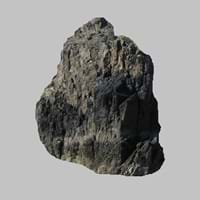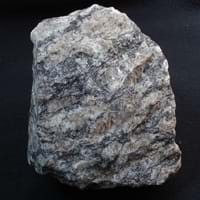Metapelite and Gneiss
Definition
Definition
Metapelite is an old and currently not widely used field geological term for a clay rich fine-grained clastic sediment or sedimentary rock, i.e. mud or a mudstone
Gneiss is a common and widely distributed type of rock formed by high-grade regional metamorphic processes from pre-existing formations that were originally either igneous or sedimentary rocks
History
Discoverer
Unknown
Unknown
Etymology
From Pelos or clay in Greek
From the Middle High German verb gneist (to spark; so called because the rock glitters)
Class
Metamorphic Rocks
Metamorphic Rocks
Sub-Class
Durable Rock, Medium Hardness Rock
Durable Rock, Hard Rock
Family
Group
Not Applicable
Not Applicable
Other Categories
Coarse Grained Rock, Fine Grained Rock, Medium Grained Rock, Opaque Rock
Coarse Grained Rock, Medium Grained Rock, Opaque Rock
Texture
Texture
Foliated
Banded, Foliated, Platy
Color
Dark Greenish - Grey, Green, Light Green, Light Greenish Grey
Black, Brown, Pink, Red, White
Maintenance
Less
More
Durability
Durable
Durable
Water Resistant
Yes
Yes
Scratch Resistant
Yes
Yes
Stain Resistant
Yes
Yes
Wind Resistant
No
Yes
Acid Resistant
No
No
Appearance
Banded
Foliated
Uses
Architecture
Interior Uses
Decorative Aggregates, Interior Decoration
Countertops, Decorative Aggregates, Flooring, Interior Decoration
Exterior Uses
As Building Stone, As Facing Stone
As Building Stone, As Facing Stone, Garden Decoration, Paving Stone
Other Architectural Uses
Curbing
Curbing
Industry
Construction Industry
Cement Manufacture, Construction Aggregate, for Road Aggregate
As Dimension Stone
Medical Industry
Not Yet Used
Not Yet Used
Antiquity Uses
Artifacts
Artifacts
Other Uses
Commercial Uses
Commemorative Tablets, Creating Artwork
Cemetery Markers, Jewelry, Tombstones, Used in aquariums
Types
Types
Not Available
Augen Gneiss, Henderson Gneiss, Lewisian Gneiss, Archean and Proterozoic Gneiss.
Features
Easily splits into thin plates, It is One of the Oldest, Strongest and Hardest Rock
Generally rough to touch, Is one of the oldest rock
Archaeological Significance
Monuments
Not Yet Used
Used
Famous Monuments
Not Applicable
Konark Sun Temple in India, Washington Monument, US
Sculpture
Not Yet Used
Not Yet Used
Famous Sculptures
Not Applicable
Not Applicable
Pictographs
Used
Not Used
Petroglyphs
Used
Not Used
Figurines
Not Yet Used
Not Yet Used
Fossils
Absent
Absent
Formation
Formation
Due to change in environmental conditions, rocks are heated and pressurized deep inside the Earth's surface. Metapelite is formed from the extreme heat caused by magma or by the intense collisions and friction of tectonic plates.
Gneiss is a high grade metamorphic rock i.e. it has been subjected to higher temperatures and pressures than schist. It is formed by the metamorphosis of Gneiss forms from volcanic rock, shale or granitie.
Composition
Mineral Content
Albite, Chlorite, Quartz
Biotite, Chlorite, Feldspar, Garnet, Graphite, Hornblade, Micas, Muscovite or Illite, Quartz, Quartzite, Silica, Zircon
Compound Content
Aluminium Oxide, CaO, MgO
Aluminium Oxide, NaCl, CaO, Iron(III) Oxide, FeO, Potassium Oxide, Magnesium Carbonate, MgO, MnO, Phosphorus Pentoxide, Silicon Dioxide, Titanium Dioxide
Transformation
Metamorphism
No
Yes
Types of Metamorphism
Not Applicable
Impact Metamorphism
Weathering
Yes
Yes
Types of Weathering
Biological Weathering, Chemical Weathering, Mechanical Weathering
Biological Weathering, Mechanical Weathering
Erosion
Yes
Yes
Types of Erosion
Chemical Erosion, Coastal Erosion, Water Erosion, Wind Erosion
Chemical Erosion, Coastal Erosion, Sea Erosion
Properties
Physical Properties
Hardness
5-6
7
Grain Size
Medium to Fine Coarse Grained
Medium to Coarse Grained
Fracture
Fibrous
Irregular
Streak
Unknown
White
Porosity
Highly Porous
Very Less Porous
Luster
Earthy
Dull
Compressive Strength
Not Available
125.00 N/mm2
17
Cleavage
Not Available
Poor
Toughness
Not Available
1.2
Specific Gravity
3.4-3.7
2.5-2.7
Transparency
Opaque
Translucent to Opaque
Density
0-300 g/cm3
2.6-2.9 g/cm3
Thermal Properties
Specific Heat Capacity
0.72 kJ/Kg K
20
Not Available
Resistance
Heat Resistant, Impact Resistant, Pressure Resistant
Heat Resistant, Pressure Resistant, Scratch Resistant, Wear Resistant
Reserves
Deposits in Eastern Continents
Asia
Not Yet Found
China, India, Iran, Iraq, Kazakhstan, Kyrgyzstan, Mongolia, Russia
Africa
Western Africa
Cameroon, Ethiopia, Ghana, Kenya, Madagascar, Morocco, Mozambique, Namibia, Nigeria, Tanzania, Togo
Europe
United Kingdom
Albania, Austria, Bosnia and Herzegovina, Finland, France, Georgia, Germany, Hungary, Italy, Kosovo, Monaco, Norway, Poland, Romania, Serbia, Slovakia, Slovenia, Switzerland, Ukraine, United Kingdom
Others
Not Yet Found
Not Yet Found
Deposits in Western Continents
North America
Not Available
Canada, Costa Rica, Cuba, Mexico, Panama, USA
South America
Brazil, Colombia, Ecuador
Argentina, Bolivia, Brazil, Chile, Colombia, Ecuador, Peru, Venezuela
Deposits in Oceania Continent
Australia
Central Australia, Western Australia
New South Wales, New Zealand, Queensland, Victoria
All about Metapelite and Gneiss Properties
Know all about Metapelite and Gneiss properties here. All properties of rocks are important as they define the type of rock and its application. Metapelite and Gneiss belong to Metamorphic Rocks.Texture of Metapelite is Foliated whereas that of Gneiss is Banded, Foliated, Platy. Metapelite appears Banded and Gneiss appears Foliated. The luster of Metapelite is earthy while that of Gneiss is dull. Metapelite is available in dark greenish - grey, green, light green, light greenish grey colors whereas Gneiss is available in black, brown, pink, red, white colors. The commercial uses of Metapelite are commemorative tablets, creating artwork and that of Gneiss are cemetery markers, jewelry, tombstones, used in aquariums.
|
||
|
||
|










